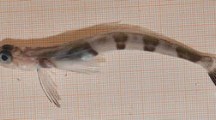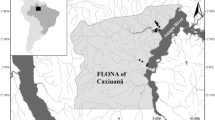Abstract
We investigated the breeding season and size at maturation and described the morphology of newly released Hippichthys spicifer larvae collected from the estuaries of four rivers on northern Okinawa-jima Island, southern Japan. The minimum size of brooding males was 108 mm standard length (SL). The smallest mature female, as estimated from gonadosomatic index (GSI) analysis and histological observations of gonads, was about 100 mm SL. Histological observations showed the gonad of H. spicifer to be a cylindrical tube with a sequential pattern of follicle development and a single germinal ridge. We surmised that the breeding season is year-round, as shown by monthly changes in female GSI, gonad histology, and monthly changes in the occurrence of brooding males. The monthly changes in female GSI and proportions of brooding males were small in winter. The number of eggs in the male brood pouch ranged from 114 to 1,764 (604.4 ± 322.8, mean ± standard deviation; n = 25). The SL of the released larvae was 9.9 mm. All fins except the pectoral fins were formed, the body was elongated, and the developmental stage was similar to that of other Urophori species. The smallest individual present in the mangrove areas of estuaries was 78.0 mm SL.








Similar content being viewed by others
References
Begovac PC, Wallace RA (1987) Ovary of the pipefish, Syngnathus scovelli. J Morphol 193:117–133
Begovac PC, Wallace RA (1988) Stages of oocyte development in the pipefish, Syngnathus scovelli. J Morphol 197:353–369
Berglund A, Rosenqvist G, Sevensson I (1986) Mate choice, fecundity and sexual dimorphism in two pipefish species (Syngnathidae). Behav Ecol Sociobiol 19:301–307
Campbell BC, Able KW (1998) Life history characteristics of the northern pipefish, Syngnathus fuscus, in Southern New Jersey. Estuaries 21:470–475
Dawson CE (1978) Review of the Indo-Pacific pipefish genus Hippichthys (Syngnathidae). Proc Biol Soc Wash 91:132–157
Gomon MF, Neira FJ (1998) Syngnathidae: pipefish and seahorses. In: Neira FJ, Miskiewicz AG, Trnski T (eds) Temperate Australian fishes: laboratory guide for larval fish identification. University of Western Australia Press, Nedlands, pp 122–131
Herald ES (1959) From pipefish to seahorse—a study of phylogenetic relationships. Proc Calif Acad Sci 29:465–473
Ishihara T, Tachihara K (2008) Reproduction and early development of a freshwater pipefish Microphis leiaspis in Okinawa-jima Island, Japan. Ichthyol Res 55:349–355
Jones AG, Avise JC (1997) Polygynandry in the dusky pipefish Syngnathus floridae revealed by microsatellite DNA markers. Evolution 51:1611–1622
Kuiter RH (2000) Seahorses, pipefishes and their relatives: a comprehensive guide to Syngnathiformes. TMC publishing, Chorleywood
Monteiro NM, Almada VC, Vieira MN (2005) Implications of different brood pouch structures in syngnathid reproduction. J Mar Biol Assoc UK 85:1235–1241
Nelson JS (1994) Fishes of the world, 3rd edn. Wiley, New York
Ohta I, Tachihara K (2004) Larval development and food habits of the marbled parrotfish, Leptoscarus vaigiensis, associated with drifting algae. Ichthyol Res 51:63–69
Selman K, Wallace RA, Player D (1991) Ovary of the seahorse, Hippocampus erectus. J Morphol 209:285–304
Senou H (2002) Syngnathidae. In: Nakabo T (ed) Fishes of Japan, with pictorial keys to the species, English ed. Tokai University Press, Tokyo, pp 520–536
Sogabe A, Matsumoto K, Ohashi M, Watanabe A, Takata H, Murakami Y, Omori K, Yanagisawa Y (2008) A monogamous pipefish has the same type of ovary as observed in monogamous seahorses. Biol Lett 4:362–365
Takahashi E, Connolly RM, Lee SY (2003) Growth and reproduction of double-ended pipefish, Syngnathoides biaculeatus, in Moreton Bay, Queensland, Australia. Environ Biol Fish 67:23–33
Takai T, Mizokami A (1959) On the reproduction, eggs and larvae of the pipe fish, Syngnathus schlegeli KAUP. Nou Sui Kou Kenhou 8:85–89
Watanabe S, Watanabe Y (2002) Relationship between male size and newborn size in the seaweed pipefish, Syngnathus schlegeli. Environ Biol Fish 65:319–325
Watanabe S, Watanabe Y, Okiyama M (1997) Monogamous mating and conventional sex roles in Hippichthys penicillus (Syngnathidae) under laboratory conditions. Ichthyol Res 44:306–310
Wilson AB, Vincent A, Ahnesjo I, Meyer A (2001) Male pregnancy in seahorses and pipefishes (family Syngnathidae): rapid diversification of parental brood pouch morphology inferred from a molecular phylogeny. J Hered 92:159–166
Acknowledgments
The authors are grateful to Emeritus Professors S. Shokita and K. Takano, Associate Professor T. Yoshino, and Assistant Professor H. Shikatani, Faculty of Sciences, University of the Ryukyus, for their kind support, and K. Maeda, Y. Mizuno, and W. Noda for valuable information. We thank the members of the Laboratory of Fisheries Biology & Coral Reef Studies, Faculty of Sciences, University of the Ryukyus, and those of the University of the Ryukyus Diving Club for help with fish collection and information. The authors also thank Associate Professor J.D. Reimer (Rising Star Tenure Track Program, University of the Ryukyus) for critical comments on the manuscript and great help with the English. This study was partially supported by the 21st Century COE program of the University of the Ryukyus.
Author information
Authors and Affiliations
Corresponding author
About this article
Cite this article
Ishihara, T., Tachihara, K. The maturity and breeding season of the bellybarred pipefish, Hippichthys spicifer, in Okinawa-jima Island rivers. Ichthyol Res 56, 388–393 (2009). https://doi.org/10.1007/s10228-009-0112-3
Received:
Revised:
Accepted:
Published:
Issue Date:
DOI: https://doi.org/10.1007/s10228-009-0112-3




